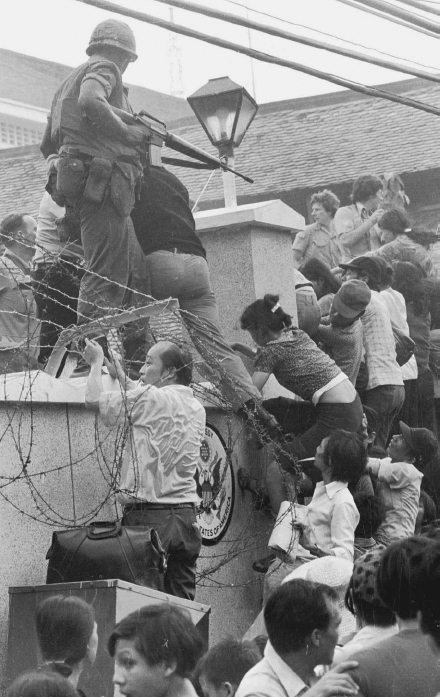The Legacy of Defeat
Printed Page 891
Antigovernment sentiment was just one of the war’s legacies. It left bitter divisions among Americans, diverted money from domestic programs, and sounded the death knell for Johnson’s Great Society. The war created federal budget deficits and triggered inflation that contributed to ongoing economic crises throughout the 1970s (as discussed in chapter 30).

Four presidents had declared that the survival of South Vietnam was essential for U.S. containment policy, but their predictions that a Communist victory in South Vietnam would set the dominoes cascading did not materialize. Although Vietnam, Laos, and Cambodia all fell within the Communist camp in the spring of 1975, the rest of Southeast Asia did not. When China and Vietnam reverted to their historically hostile relationship, the myth of a monolithic Communist power overrunning Asia evaporated.
The long pursuit of victory in Vietnam complicated the United States’ relations with other nations, as even its staunchest ally, Britain, doubted the wisdom of the war. The use of terrifying American power against a small Asian country compromised efforts to win the hearts and minds of people in developing nations.
The cruelest legacy of Vietnam fell on those who had served. “The general public just wanted to ignore us,” remembered Frederick Downs, while opponents of the war “wanted to argue with us until we felt guilty about what we had done over there.” Many veterans believed in the war’s purposes and felt betrayed by the government for not letting them win it. Other veterans blamed the government for sacrificing the nation’s youth in an immoral, unnecessary war, expressing their sense of the war’s futility by referring to their dead comrades as having been “wasted.” Some veterans belonging to minority groups had more reason to doubt the nobility of their purpose. A Native American soldier assigned to resettle Vietnamese civilians found it to be “just like when they moved us to the rez [reservation]. We shouldn’t have done that.”
Because the Vietnam War was a civil war involving guerrilla tactics, combat was especially brutal (Table 29.1). The terrors of conventional warfare were multiplied, and so were the motivations to commit atrocities. The 1968 massacre at My Lai was only the most widely publicized war crime. To demonstrate the immorality of the war, peace advocates stressed the atrocities, contributing to a distorted image of the Vietnam veteran as dehumanized and violent.
TABLE 29.1 Vietnam War Casualties
| Table 29.1 Vietnam War Casualties | |
| United States | |
| Battle deaths | 47,434 |
| Other deaths | 10,786 |
| Wounded | 153,303 |
| South Vietnam | |
| Killed in action | 110,357 |
| Military wounded | 499,026 |
| Civilians killed | 415,000 |
| Civilians wounded | 913,000 |
| Communist Regulars and Guerrillas | |
| Killed in action | 66,000 |
| Source: U.S. Department of Defense. | |
Most veterans came home to public neglect. Government benefits were less generous to Vietnam veterans than they had been to those of the previous two wars. While two-thirds of Vietnam veterans said that they would serve again, and while most veterans readjusted well to civilian life, some suffered long after the war ended. The Veterans Administration estimated that nearly one-sixth of the veterans suffered from post-traumatic stress disorder, experiencing recurring nightmares, feelings of guilt and shame, violence, substance abuse, and suicidal tendencies. Thirty years after performing army intelligence work in Saigon, Doris Allen “still hit the floor sometimes when [she heard] loud bangs.” Some who had served in Vietnam began to report birth defects, cancer, severe skin disorders, and other ailments. Veterans claimed a link between those illnesses and Agent Orange, which had exposed many to the deadly poison dioxin in Vietnam. In 1991, Congress began to provide assistance to veterans with diseases linked to the poison.
By then, the climate had changed. The war began to enter the realm of popular culture, with novels, TV shows, and hit movies depicting a broad range of military experience — from soldiers reduced to brutality, to men and women serving with courage and integrity. The incorporation of the Vietnam War into the collective experience was symbolized most dramatically in the Vietnam Veterans Memorial unveiled in Washington, D.C., in November 1982. Designed by Yale architecture student Maya Lin, the black, V-shaped wall inscribed with the names of 58,200 men and women lost in the war became one of the most popular sites in the nation’s capital. In an article describing the memorial’s dedication, a Vietnam combat veteran spoke to and for his former comrades: “Welcome home. The war is over.”
QUICK REVIEW
Question
What strategies did Nixon implement to bring American involvement in Vietnam to a close?
CHAPTER LOCATOR
How did U.S. foreign policy change under Kennedy?
Why did Johnson escalate American involvement in Vietnam?
How did the war in Vietnam polarize the nation?
How did U.S. foreign policy change under Nixon?
Conclusion: Was Vietnam an unwinnable war?
 LearningCurve
LearningCurve
Check what you know.